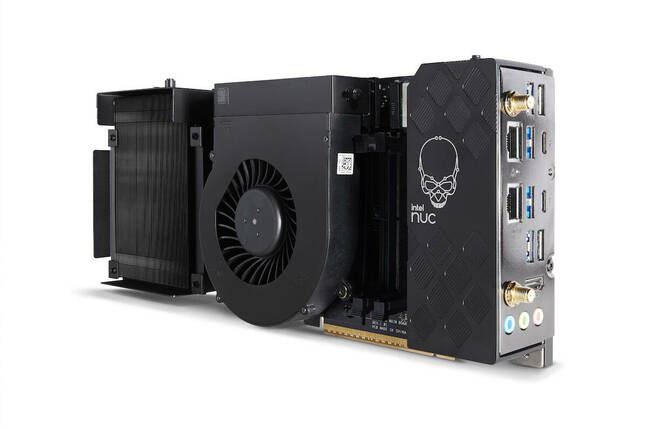[ad_1]
Intel wants to put a small form factor space heater – err PC – on your desk with the launch of its 13th-Gen NUC Extreme platform, codenamed Raptor Canyon.
The 14 liter system [PDF] can be equipped with your choice of full-fat 13-gen desktop processors, including the company’s overclockable Core i9 13900K.
The 24-core, 32-thread chip has a 253W thermal design power (TDP) and despite Intel’s claims of improved thermals over last year’s Dragon Canyon NUC, we have our doubts that the rather anemic fan pictured is to the a challenge
In addition to powerful CPUs, Intel claims that the larger ventilated chassis of the tiny system is enough to support a 12-inch, three-slot GPU up to 450W. At maximum, this would put the system’s total power at a fairly comfortable 700-plus watts, although that would stretch the 750W 80+ Gold power.
Intel’s Next Unit of Computing was originally intended as a bare-bones showcase for dense yet powerful small form factor computers. However, over the past few years the company’s lineup has expanded as the chipmaker swapped out laptop CPUs for desktops and made way for full-sized dedicated GPUs.
For the 10th anniversary of the NUC, Intel has embraced a new design philosophy that makes heavier use of mesh and stacks the base system above the dedicated GPU, as opposed to stacking them back-to-back like last year’s model.

Intel’s NUC 13 Extreme Compute Element can be equipped with a 253W 13-gen Core i7 or Core i9, or a cheaper Core i5. – Click to enlarge
As with previous NUCs, the system is modular with the CPU, RAM, storage and I/O packaged in a self-contained daughterboard Intel calls the NUC Extreme Computing Element. Intel actually offers the Compute Element as a standalone system, however, we’re told the system is not backwards compatible with earlier 11th or 12th gen NUC Extreme systems.
“The NUC 13 Extreme is a completely new design and is not intended to be backwards compatible,” an Intel spokesperson said. The Register in response to questions.
The Computing Element can be equipped with up to 64GB of DDR5 5,600MHz memory via twin SODIMM slots, while the system can be equipped with up to three PCIe 4.0 NVMe SSDs for storage. The NUC also supports a host of high-speed I/O, including dual Thunderbolt 4 ports, six 10Gbit/sec USB3.2 Gen 2 ports, and 2.5Gbit/sec (Intel i226-V) and 10Gbit/sec (Aquantia AQC113) NICs. Finally, wireless connectivity is achieved with Intel’s Killer Wi-Fi 6E module.
All of that is packed into a system not much bigger than a graphics card. The compute module interfaces with the rest of the system using an edge connector that provides connectivity to the PCIe 5.0 16x slot used by the GPU.
The NUC 13 Extreme will initially be available in China, with wider availability in the fourth quarter and 2023. But it won’t be cheap. The complete system can be had for between $1,179 and $1,549 or between $760 and $1,100 for the Compute Element, depending on whether you opt for an i5, i7 or i9 processor. However, those prices don’t include a dedicated GPU, memory, storage, or the operating system, which can easily add another $600-$1,000 to the price tag.
Anyone interested in picking up one of these company workstations may want to hurry. Faced with poor sales figures – 10 million units in 10 years – at least one of our fellow vultures expects that the NUC line will not long survive CEO Pat Gelsinger’s chopping block. ®
[ad_2]
Source link
